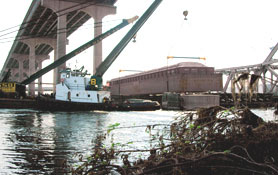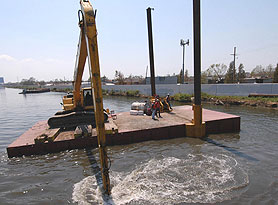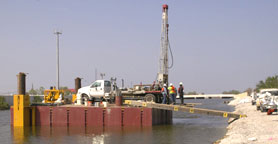Hurricane eMatrix
List of Activity Sheets » Restoration of maritime infrastructure and water-related activities
Deep-Water Work/Boating Operations

This picture shows actual disaster site work conditions and may not illustrate proper safety and health procedures.
Activity Description
- This activity sheet is for those who use or work from vessels to conduct hurricane-related assessment, recovery, and restoration activities.
- For some operations or situations (e.g., heavy equipment use, diving operations/SCBA) other activity sheets also apply; see related activity sheets below.
- Hurricanes Katrina and Rita (2005) affected many structures (e.g., bridges, oil rigs, levees) that are best-assessed and repaired directly from vessels or using vessels as platforms for operations (e.g., involving divers).
- While many assessment-and-repair activities conducted from vessels or using vessels as platforms are similar to those carried out on land, some additional hazards may be present. Since most of this type of work will involve larger, Coast Guard-inspected commercial vessels, owner/operators should already be aware of vessel navigation-related safety and stability issues and of applicable Coast Guard regulations.
- Response and recovery workers conducting this operation may be employed by Federal, State, local, and private employers. Review How to Use This Matrix in the introduction for a discussion of how this information may apply to different workers.
About the Activity Sheet
This activity sheet does not provide an in-depth analysis of OSHA standards and regulations and cannot address all hazards. It does not increase or diminish any OSHA requirement or employer obligation under those requirements. It is intended as a guide and quick reference for employers and response and recovery workers. The Matrix captures major activities involved in hurricane response and recovery, highlights many of the hazards associated with them, and recommends beneficial work practices, personal protective equipment (PPE), and other exposure control methods. Employers must evaluate the specific hazards associated with the job/operation at the site where the work is being performed.
Employers are responsible for providing a safe and healthful workplace for their workers. OSHA's role is to assure the safety and health of America's workers by setting and enforcing standards; providing training, outreach, and education; establishing partnerships; and encouraging continual improvement in workplace safety and health.
The Hazard Exposure and Risk Assessment Matrix for Hurricane Response and Recovery Work provides a general overview of particular topics related to current OSHA standards. It does not alter or determine compliance responsibilities in OSHA standards or the Occupational Safety and Health Act of 1970, or the equivalent State Plan standards and requirements. Because interpretations and enforcement policy may change over time, you should consult current OSHA/State Plan administrative interpretations and decisions by the Occupational Safety and Health Review Commission and the courts for additional guidance on OSHA compliance requirements. Employers should modify their procedures as appropriate when additional, relevant information becomes available.
General Recommendations
Key Engineering Controls and Work Practices. See general recommendations document.
Personal Protective Equipment. The general PPE is recommended for all response/recovery tasks/operations; only the additional PPE that may be needed for a specific hazard is noted below.
General PPE includes:
- Hard hat for overhead impact or electrical hazards
- Eye protection with side shields
- Gloves chosen for job hazards expected (e.g., heavy-duty leather work gloves for handling debris with sharp edges and/or chemical protective gloves appropriate for chemicals potentially contacted)
- ANSI-approved protective footwear
- Respiratory protection as necessary-N, R, or P95, filtering facepieces may be used for nuisance dusts (e.g., dried mud, dirt and silt) and mold (except mold remediation). Filters with a charcoal layer may be used for odors
Recommendations Specific to Hazards Associated with Deep-Water Work/Boating Operations
Key Engineering Controls and Work Practices

- Comply with Coast Guard manning and safety equipment regulations (e.g., licensed/qualified staff based on size and service of the vessel, personal floatation devices, lifeboats, flares, charts for area of operation) applicable to the commercial operation of the vessel, including those related to vessel inspections (see Other Resources and References)
- Ensure that vessels used to pull or push other platforms (e.g., barges) are of suitable design and horsepower
- Take extra care when navigating because landmarks, navigational aids, and underwater hazards may have shifted. Also look for overhead hazards from tree limbs, hanging power lines, and other debris that may fall and/or strike response and recovery workers
- Use buoys to mark locations of submerged materials
- Do not allow workers to pass fore, aft, over, between, and around barge decks unless there is a walkway or another means for safe passage
- Provide fall protection if individuals must stand at an outboard or inboard edge without sufficient bulwark, rail, coaming or other protection
Additional Personal Protective Equipment
- Coast Guard-approved Type I or II personal floatation devices
Key Engineering Controls and Work Practices
- Ensure that heavy equipment brought aboard a vessel will not affect the vessel's stability during any expected conditions of response/recovery operations (e.g., man lift extended to inspect a bridge trestle)
- See Heavy Equipment and Powered Industrial Truck Use activity sheet
- See Crane Use activity sheet
Additional Personal Protective Equipment
- Hearing protection-see Noise hazard
Key Engineering Controls and Work Practices
- See the Diving and Diver-Support Operations activity sheet
Key Engineering Controls and Work Practices
- Use ground-fault circuit interrupters (GFCIs) or double insulated power tools, or implement an assured equipment grounding program
- Inspect power tool condition (including any cords) and verify operation of safety features before use
- Do not use equipment that is defective, such as equipment with inoperable safety switches, missing guards, frayed/cut cords etc.
- Ground power tools properly
- Avoid standing in wet areas when using portable power tools
Additional Personal Protective Equipment
- Hearing protection-see Noise hazard
- Hand protection for cut- and abrasion-control and vibration dampening
- Eye protection appropriate to the impact hazard
Key Engineering Controls and Work Practices
- Use OSHA shipyard and National Fire Protection Association (NFPA) procedures as guidance for safe work practices when conducting "hot work" such as welding, cutting, or burning on vessels not in a shipyard (see Other Resources and References)
- Remove flammable and combustible materials from the area
- Do not perform hot work in areas where flammable, combustible, corrosive, or toxic substances are being used, stored, or may otherwise be present
- Maintain a fire watch during all hot work until material has cooled
- Ensure fire extinguishers and extinguishing agents are available in the immediate area
- Provide natural, exhaust, or forced ventilation to control exposure to the metal fumes and other contaminants being generated (e.g., generator exhaust)
- Ensure that pipes and other vessels are purged of hazardous materials
- Identify building materials that will be welded, cut, or burned and that may contain lead, such as painted surfaces and pipes. Test materials and provide exposure controls identified in 29 CFR 1926.62 as necessary; see the lead hazard in the general recommendations document
Additional Personal Protective Equipment
- Gloves and protective clothing for the activity being performed
- At a minimum, filtered lenses and face-protection as appropriate for the activity being performed
- Respiratory protection based on anticipated exposure to metal fumes, including lead
Key Engineering Controls and Work Practices

- When a contaminated-water splash hazard is present (e.g., when divers are entering the water, when recovering submerged objects or debris), keep non-essential response and recovery workers away from the splash-hazard zone
- Ensure that good hygiene, especially hand washing, is practiced before eating, drinking, and smoking. If clean water is not available, use an alternative such as hand sanitizer or sanitizing wipes
- Ensure that cuts and bruises are protected from contact with contaminated water
- Clean areas of the body that come in contact with contaminated water with soap and water, hand sanitizer, or sanitizing wipes
- If divers are involved, ensure divers and their equipment are appropriately decontaminated (fresh water shower/rinse at minimum) upon completion of dive operations-see Diving and Diver-Support Operations activity sheet
Additional Personal Protective Equipment
- Goggles if routinely working near splashing floodwater
- N, R, or P95 respirators may be necessary for exposure to contaminated water that may become aerosolized
- Watertight boots with steel toe and insoles
- Waterproof gloves for contact with contaminated water
Key Engineering Controls and Work Practices
- Remove or secure objects (glass, structural members) that may fall while workers work under them
- Use debris netting, sidewalk sheds, canopies, or catch platforms to reduce hazards from falling objects
- Verify the location of all other utility lines; ensure lines have been shut-off, capped, or otherwise controlled outside the building before beginning work. Notify utility companies before controlling their utility lines
- Assess the presence, contents, and condition of tanks and equipment that might contain hazardous chemicals, gases, or flammable materials. If the condition of tanks or equipment is suspect, avoid disturbing them until after the assessment is done and a plan of action determined
- Purge lines, tanks, and equipment containing hazardous chemicals, gases, or flammable materials. Use air monitoring equipment such as a combustible gas indicator, toxic gas monitor, or oxygen monitor to determine if any hazardous conditions remain. When necessary, provide additional controls to protect response and recovery workers (e.g., forced ventilation, respiratory protection)
- Provide and use safe walkways to reach any point without having to walk on exposed beams; walkways should be at least 18 inches wide and formed by using 2-inch thick wood, with stringers installed as needed for support
Key Engineering Controls and Work Practices
- Confined spaces have limited means of entry or exit, are large enough to bodily enter, and may contain physical (e.g., mechanical, electrical, hydraulic, pneumatic energy; engulfment hazards; inwardly converging surfaces) or atmospheric hazards (e.g., atmospheres that are oxygen-deficient or oxygen-enriched, contain or may contain flammable gas, vapor or mist, airborne combustible dust, toxic substances, or any other atmosphere that is immediately dangerous to life or health). Examples include storage tanks, process vessels, bins, boilers, vaults, ventilation or exhaust ducts, sewers, tunnels, pipelines, and pits more than 4 feet in depth
- Hurricane-related events might introduce hazards or potential hazards into confined spaces. For example, a space might have a potential to contain a hazardous atmosphere due to the presence of decomposing organic matter, to the use of hazardous chemicals in the space, or to the performance of operations in the space, such as welding, cutting, or burning, that may create a hazardous atmosphere. Additional precautions must be taken to make the space safe for entry
- Evaluate the need for entry (i.e., placing any body part into the space)
- For entry into maritime-related confined spaces (vessels and platforms), ensure that entry procedures account for potential hazards from adjacent spaces and piping systems in spaces, and from the previous three cargoes handled
- If entry is required, see Entry into Confined Spaces activity sheet
Key Engineering Controls and Work Practices
- Assume that electrical lines are energized until proven otherwise. Lines and other conductors may become re-energized without warning as utilities are evaluated and restored after a disaster
- Inspect the work area for downed conductors and do not go near, drive over, or otherwise come in contact with them
- Downed electrical conductors can energize other objects, including fences, water pipes, bushes, trees, and telephone/CATV/fiber optic cables
- Unless de-energized and visibly grounded, maintain proper distance from overhead electrical power lines (at least 10 feet) and/or provide insulating barriers
- Do not approach any gas leaks; if a gas leak is detected, secure spark-producing devices (e.g., engines, tools, electronic, and communications equipment) and evacuate the area until the leak is secured
- Contact utility company to assist in locating, marking, and shutting off/purging utility lines that may pose a hazard or may be impacted; ensure that lines have been purged as needed before beginning work
Key Engineering Controls and Work Practices
- Never attach a generator directly to the electrical system of a structure unless a qualified electrician has installed a transfer switch for the generator. If the structure's electrical system is not isolated, it may energize the utility's wiring system for great distances and create a risk of electrocution for utility workers and others in the area
- Always plug electrical equipment directly into the generator using the manufacturer's supplied cords or grounded (3-pronged) extension cords that are rated for the total anticipated load
- Do not overload a generator; it can overheat and create a fire hazard
- Ground and bond generators according to the manufacturer's recommendations; ensure that any manufacturer-required connections are secure before using the generator
- Keep the generator dry; protect with a canopy if needed; do not use it in wet or rainy conditions
- Carbon monoxide (CO) is a poisonous, colorless, and odorless gas that is produced by the incomplete burning of the generator's fuel. CO is harmful when breathed because it displaces oxygen in the blood and deprives the heart, brain, and other vital organs of oxygen
- Never use a generator indoors or in enclosed spaces such as garages and basements; opening windows and doors may not prevent CO from building up in those spaces. Do not use a generator outdoors near doors, windows, and vents that could allow CO to enter
- Ensure that a generator has 3 to 4 feet of clear space on all sides and above it to ensure adequate ventilation and cooling
- Before refueling, shut down the generator and allow it to cool
Additional Personal Protective Equipment
- Hearing protection-see Noise hazard
Key Engineering Controls and Work Practices
- Place generators, compressors, and other noisy equipment at a distance or behind a barrier when possible
Additional Personal Protective Equipment
- Hearing protection when working around potential noise sources and when noise levels exceed 90 dBA. A useful "rule of thumb"-if you cannot hold a conversation in a normal speaking voice with a person who is standing at arms length (approximately 3 feet), the noise level may exceed 90 dBA
Key Engineering Controls and Work Practices

- If hazardous chemical containers are found or leaking materials are detected:
- Do not use spark-producing devices (e.g., engines, tools, electronic, and communications equipment) in the immediate area
- Take self-protective measures (i.e., move to a safe distance upwind) and contact hazardous material response personnel for evaluation/removal before continuing work in the area
- Use a float/buoy to mark the location of the chemical container
Additional Personal Protective Equipment
- Evaluate the need to revise protective clothing, respirator, and glove selection
Select any of the following potential hazards that can be associated with this activity in order to access relevant recommendations in the general recommendations document:
- Slips, trips, and falls on working surfaces
- Environmental hazards
Additional Medical Needs
- Follow medical guidance and precautions outlined in the general recommendations document
Additional Training Needs
- Follow general site- and task-specific training guidelines as outlined in the general recommendations document
- Ensure vessel personnel are licensed as needed
Related Activity Sheets
- Assessment, Cleanup, and Repair of Structures
- Removal of Floodwaters from Buildings and Initial Entry into Previously Flooded Building Areas
- Search and Rescue
- Debris Collection
- Roadway and Bridge Inspection and Repair
- Community Floodwater Removal and Levee Repair
- Diving and Diver-Support Operations
- Entry into Confined Spaces
- Heavy Equipment and Powered Industrial Truck Use
- Crane Use
Other Resources and References
- 46 CFR (Coast Guard), Requirements for manning and safety equipment for inspected vessels. National Archives and Records Administration, (2004).
- 29 CFR 1915.14, Hot work (OSHA Maritime Standard - Shipyards). OSHA Standard.
- 29 CFR 1915 Subpart B, Confined and Enclosed Spaces and Other Dangerous Atmospheres in Shipyard Employment. OSHA.
- 29 CFR 1926.106, Working Over or Near Water. OSHA Standard.
- 29 CFR 1926 Subpart O, Motor vehicles, mechanized equipment, and marine operations. OSHA.
- NFPA 306, Control of Gas Hazards on Vessels. National Fire Protection Association Standard, (2003).
- Procedures for Atmospheric Testing in Confined Spaces. OSHA Quick Card, (2005).
- Storm/Flood and Hurricane Response. National Institute for Occupational Safety and Health (NIOSH) Workplace Safety and Health Topic.
- Confined Spaces. OSHA Safety and Health Topics Page.
- Portable Ladder Safety Tips. OSHA Quick Card, (2005).
- Using Portable Generators Safely. OSHA Fact Sheet, (2005).

